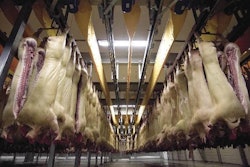So said American veterinary experts when they addressed a recent international meeting on the disease. By the calculations of these animal health specialists from Iowa State University, every 2 US cents increase in the price of a kilogram of maize means another US$18.45 million per year added to the economic impact of PRRS on American pork production. US$0.02/kg is equivalent to US$0.50/bu where corn is priced in bushel weight.
It is only logical that PRRS becomes more expensive in terms of mortality, morbidity and treatment as the costs of all farm inputs rise, said the Iowa experts. A study published in 2005 based on corn at US$0.088/kg (US$2.25/bu) had estimated the disease to be costing the national pig industry in the USA almost US$562 million per year. When maize is priced at 20 US cents per kilogram ($5.00/bu), however, the annual cost of PRRS to US producers goes above $664 million.
These analysts pointed out that rising corn prices are less damaging to production costs in the sow herd than on nursery and grow-finish sites. In their former study the largest share (US$286.86 million) was felt by finishing units, with a US$229.64 million hit for nursery sites and US$45.39 million in sow herds.
The calculations at the time gave a cost of US$7.67 per pig on affected farms in the finishing phase through a combination of more deaths (US$3.23), poorer feed conversion (US$3) and slower growth (US$1.44). Losses of more than US$6 per pig in the nursery phase came from combining US$3.58 for the higher mortality rate with US$1.17 for less efficient feed conversion and US$1.26 for a reduced average daily weight gain. This compared with over US$74 per litter for the breeding/farrowing phase when adding together US$45 due to weaning fewer pigs per litter and the US$29 or so attributed to a reduced farrowing rate.
In the PRRS-affected finishing unit, said the analysts, every $0.50 extra in the price of a bushel of corn means another US$0.405 on the production cost per pig marketed. At the nursery site this becomes US$0.072 per pig. So the current corn price environment would imply a total of around US$9.90 per pig added at finisher level and US$6.40 per pig for nurseries.
PRRS was first reported in USA in the late 1980s, attendees at the International PRRS Symposium were reminded during the meeting held in Chicago. The first outbreaks in Europe were observed in 1990. The virus spread rapidly afterwards and has been devastating the global swine industry since the early 1990s. Among individual countries mentioned in reports to the symposium, it was reported for the first time in Germany in 1990, in Russia in 1993 and in China in 1995.
By contrast, Sweden's first case of the disease was confirmed only in July last year. A presentation by the Swedish national veterinary institute explained that antibody-positive samples were found through routine sampling within the national PRRS serosurveillance programme which has been conducted since 1994. A total of 8 herds, all situated in the south of Sweden, were declared infected within a timeframe of 10 days. Although no clinical symptoms were seen, follow-up investigations noted some suboptimal reproduction figures.
Blood sampling was done on neighbouring farms and at slaughterhouses to trace infected herds. Fortunately, the results showed that the spread of the virus had been restricted to a relatively narrow zone. The work since then has concentrated mainly on certifying that Sweden is back to being PRRS-free. It has meant checking serum samples from each one of the 1000 or so Swedish units that market more than 300 slaughter pigs annually, as well as a selected number of the smaller ones.
A diversity of types
Work to identify the genetic type of the virus present was an important part of the epidemiological studies in Sweden last year. In Germany, where PRRS has become endemic since the first outbreaks were observed in 1990, Hannover's veterinary university has cooperated with Intervet International on typing field strains recovered from herds in Lower Saxony — the region of the country with the highest pig density.
They found that the viruses isolated from diagnostic samples obtained between 2004 and 2007 were closely related and most formed their own distinct genetic cluster which differed from those seen in other European countries. However, there was also evidence that new types were being introduced to the region through the importation of pigs from other areas. A further possibility seemed to be that the occurrence of North American-type virus had increased with the introduction of modified-live vaccines to control the disease. Of 226 isolates analysed, 57% were European-type — and 15 out of these 130 showed a relationship to the European virus strain used in modified-live vaccination. The other 43% of isolates were closely related to North American-type vaccine virus strain.
The genetic diversity and serological prevalence of PRRS virus has also been investigated in Taiwan, by the National Chiayi University there. Checks on 630 blood samples collected from 21 units in 2005 identified that all these enterprises were PRRS-positive. Each of 42 viruses isolated belonged to the North American type. From follow-up analyses it emerged that Taiwan's version of PRRS viruses at the time were genetically quite diverse and formed at least 5 major clusters. Genome sequencing of 5 isolates from these clusters confirmed that although they were of the North American type, they seemed to have evolved into a group which differed distinctly from others of the same type found elsewhere.
A significant increase in the diversity of PRRSV strains circulating in British herds between the 1990's has been determined by the Veterinary Laboratories Agency in the UK. This has consequences for the diagnostic methods used in Britain currently, the research team pointed out. When a panel of 12 monoclonal antibodies was tested, only one reacted with all the viral isolates.
The extra diversity came to light after the genetic sequence of viruses in tissue samples obtained from clinical cases of the disease between 2004 and 2007 was compared with data for 16 strains isolated in Britain during 1991-1995. Over 110 isolates have been characterised in this work and all were of the European genotype. Several proved to be highly similar to the vaccine strain used in Britain. But the genetics of viruses associated with disease have become more diverse with time.
Highly pathogenic in China
China has had its own problems with an especially pathogenic form of PRRSV, of course. Eleven years after the first appearance of the disease nationally in 1995, this hot version emerged in the south and centre of the country in mid-2006 and soon afterwards had spread to most parts of the mainland. Chinese scientists reported to the 2007 international PRRS symposium that the disease has been marked by a prolonged high fever, with the body temperature of affected pigs exceeding 41oC. Red ears and skin with hard dung were other early signs, before the rapid onset of severe respiratory troubles and diarrhoea that often preceded death: the mortality rate in some more extreme outbreaks reached 80-100%. Pneumonia and haemorrhages in the lungs have been regular features found at post mortem.
Several investigating centres in China confirmed that although the offending virus was of the North American type, it showed genetic differences from other forms seen previously on the mainland or in other countries. Its similarity to so-called classical PRRS viruses was only in the range 70-86%. Moreover, the sequencing of its genome confirmed that the same differences occurred regardless of the geographic area from which the sample had been obtained.
At the Shanghai institute of veterinary research and China Agricultural University in Beijing, investigators now say the high-fever PRRS was responsible for 20 million pigs being killed or culled. All signs point to the virus being a mutated strain. According to University of Hong Kong studies, however, look-alike outbreaks that hit farms in Hong Kong in early 2007 were not due to an identical virus.PIGI

















